
About UsThe Numismatic Bibliomania Society is a non-profit organization promoting numismatic literature. For more information please see our web site at coinbooks.org SubscriptionsThose wishing to become new E-Sylum subscribers (or wishing to Unsubscribe) can go to the following web page link MembershipThere is a membership application available on the web site Membership Application To join, print the application and return it with your check to the address printed on the application. Membership is only $15 to addresses in the U.S., $20 for First Class mail, and $25 elsewhere. For those without web access, write to: David M. Sundman, Secretary/TreasurerNumismatic Bibliomania
Society AsylumFor Asylum mailing address changes and other membership questions, contact David at this email address: dsundman@LittletonCoin.com SubmissionsTo submit items for publication in The E-Sylum, just Reply to this message, or write to the Editor at this address: whomren@coinlibrary.com
BUY THE BOOK BEFORE THE COINYou won't regret it! |
- WAYNE'S WORDS: THE E-SYLUM OCTOBER 16, 2011
- SKLOW BID SALE NO. 14 PRICES REALIZED ARE AVAILABLE
- NEW BOOK: STANDARD GUIDE TO SMALL-SIZE U.S. PAPER MONEY, 10TH ED.
- DR. JOHN E. WILKISON OF SPRINGFIELD, TENNESSEE
- DR. JOHN WILKINSON OF CANADA
- SKEWING - A TECHNIQUE FOR SIGNATURE IDENTIFICATION
- MEASURING IRREGULARLY SHAPED NUMISMATIC ITEMS
- ASSISTANCE WITH PERIODICALS SOUGHT FOR THE NBS ONLINE BIBLIOGRAPHY
- MORE ON THE SHIP OF THE LINE VIRGINIA
- WAYNE'S NUMISMATIC DIARY: OCTOBER 16, 2011
- QUERY: WHAT IS A SAMMY MARKS PENNY?
- THE CELTIC COIN INDEX
- THE JOURNAL OF ANCIENT NUMISMATICS, VOLUME 4
- MORE ON ENGRAVER PHILIP RANDALL
- STAMPS ON PAPER MONEY
- NOTES FROM E-SYLUM READERS: OCTOBER 16, 2011
- ROYAL MINT ISSUES DIAMOND JUBILEE FIVE POUND COMMEMORATIVE
- DAILY MAIL ARTICLE ON ELIMINATING THE U.S. DOLLAR BILL
- HOW NOT TO STORE A COIN COLLECTION
- FEATURED WEB PAGE: ATTINELLI'S NUMISGRAPHICS
WAYNE'S WORDS: THE E-SYLUM OCTOBER 16, 2011

Among our new subscribers this week are Travis Hearn, courtesy of Dave Bowers, Serge Melkizian and Mark Williams. Welcome aboard! We have 1,462 email subscribers, plus 166 followers on Facebook, including Eric Schena.
This week we open with a report from David Sklow on his recent numismatic literature sale. Other topics this week include the Celtic Coin Index, the Journal of Ancient Numismatics, and measuring irregularly shaped coins.
To learn more about Dr. John and Dr. John, skewing, Sammy Marks tickeys, the Queen's Diamond Jubilee and how not to store a coin collection, read on. Have a great week, everyone!
Wayne Homren
Numismatic Bibliomania Society
SKLOW BID SALE NO. 14 PRICES REALIZED ARE AVAILABLE
 Mail bid sale no. 14 featuring the paper money works and scarce items from the library of Myron Xenos is now closed – some results from the sale are listed below.
The Prices Realized are viewable on our website NOW!
Mail bid sale no. 14 featuring the paper money works and scarce items from the library of Myron Xenos is now closed – some results from the sale are listed below.
The Prices Realized are viewable on our website NOW!
- Lot 13 The Hyperinflation Collection brought $195 on spirited bidding!
- Lot 348 Senate Letters attracted several interested bidders driving it to $825!
- Lot 416 Stack's June 28, 1940 had multiple bidders resulting in $145 finish!
- Lot 683 American Bond Detector with a great pedigree realized only $1700.
- Lot 689 Deluxe Bowers &Merena Norweb Sales Copy # 4 brought $1681 on a heavily reduced bid!
- Lot 702 Cooper's Art & Craft of Coin Making attracted more bids than any other lot in the sale and hammered down at $533 on a reduced bid!
- Lot 894 The Very Scarce Deluxe Leather Mehl Catalogue of the Mores, Faelten and Todd Collections obtained a final price of $2007 after a war of bidding!
Mail Bid Sale # 15 will be February 11, 2012
DAVID SKLOW – FINE NUMISMATIC BOOKS
P.O. BOX 6321
COLORADO SPRINGS, CO 80934
TEL: (719) 302-5686
FAX: (719) 302-4933
finenumismaticbooks@aol.com
www.finenumismaticbooks.com
NEW BOOK: STANDARD GUIDE TO SMALL-SIZE U.S. PAPER MONEY, 10TH ED.
 Krause Publications has released the 10th edition of the Standard Guide to Small-Size U.S. Paper Money.
Krause Publications has released the 10th edition of the Standard Guide to Small-Size U.S. Paper Money.
Authored by leading paper money experts John Schwartz and Scott Lindquist, the Standard Guide is the ultimate price guide for dealers and collectors of small-size U.S. paper money. Features include:
- 300+ color photographs
- Complete serial number data
- Current market values in up to four grades of condition
- Precise quantities of notes printed observed
- Design and production details
For more information visit www.sellcoinbooks.com/us-paper-money/standard-guide-to-small-size-u-s-paper-money-10th-edition
HOW MANY OF THE 100 GREATEST MODERN COINS
DO YOU OWN?
DR. JOHN E. WILKISON OF SPRINGFIELD, TENNESSEE
Jeff wrote:
David Stone writes:
Regarding Jeffrey LaPlante's question about Dr. John E. Wilkison, he was a collector from Springfield, Tennessee who amassed a fabulous gold pattern collection over a period of three decades, which was purchased by Paramount in September 1973.
David Akers, who worked at Paramount at that time, based his excellent reference United States Gold Patterns on Dr. Wilkison's collection. The collection was the most complete set of gold patterns ever acquired at that time, and it is doubtful that it will ever be equaled. I believe most of the coins were later purchased by A-Mark. It was probably Farouk's wonderful pattern collection that Wilkison was interested in.
Others are referring to the prominent Canadian collector Dr. John Wilkinson, with an "n" in his name. LaPlante was inquiring about Dr. John E. Wilkison, with no "n".
Some other items that may help:
1. R. Green was the business style of Chicago coin dealer Charles E. Green, after his wife Ruth. He started out as a dealer about 1935 and continued until his death in 1955, only a year or so after the Farouk sale. He published the booklet Mint Records of U.S. Coins 1793-1931 , Inclusive, which Louis Eliasberg used as a checklist to keep track of his collection. He never worked for Sotheby's as far as I know, so he must have sent Wilkison a copy of the sale that he obtained from somebody else, possibly just ordered the copy from Sotheby's.
2. Neither Wilkison nor Green actually attended the Farouk sale in Cairo. I believe the only Americans at the sale were John Jay Pittman, the Norwebs, Abe Kosoff and family, James Randal, Robert Schermerhorn, Gaston DiBello, Sol Kaplan and his wife, and Paul Wittlin.
Hans Schulman, who was born in Amsterdam but emigrated to America in 1939, was also there, and David Spink was on hand representing several clients, including the Norwebs.
The notes in the catalog must be observations Wilkison made at home, or perhaps he acquired a sales-room copy from someone who was actually there. MANY of the coins in his collection were pedigreed to Farouk, so he undoubtedly participated in the sale in a big way. Probably one of the American coin dealers acted as his agent.
David Akers book on gold patterns is a must for anyone interested in Wilkison or gold patterns in general. It was published in 1975 I think, and has been out of print for some time, but it is not very expensive and can often be found through the offerings of numismatic literature dealers or on eBay. I highly recommend it
Howard Cohen writes:
The following website will provide the history and the complete listing of Dr. Wilkison's unique collection of United States Gold Patterns: www.pcgs.com/setregistry/alltimeset.aspx?s=22286
Several of his patterns were obtained from the famous Palace (Farouk) Collection held in Cario in1954. The book by David Akers "United States Gold Patterns" published in 1975 is a complete listing, but more important is the photography showing the beauty in color of these gold coins.
- Kolbe sale 31 lot 514
- Kolbe sale 41 lot 800
- Kolbe sale 77 lot 611
- Kolbe sale 80 lots 11 and 586
- Kolbe sale 83 lot 184
- Kolbe sale 92 lot 106
- Kolbe sale 96 lot 1108
Thanks! There is a ton of information out there. The problem is often just knowing where to find it. -Editor
To read the earlier E-Sylum article, see: QUERY: INFORMATION ON DR. JOHN E. WILKISON SOUGHT (www.coinbooks.org/esylum_v14n42a15.html)
DR. JOHN WILKINSON OF CANADA

Joe Foster writes:
There was a Dr. John S. Wilkinson of Ontario, president of the CNA 1961 to 1963; published article in CNA journal vol. 14, #6 June 1969 "Athenian Silver Coin Fractions"... I believe he sold his collection in 1973, in conjunction with ANA convention.....he was a rather well-known Canadian numismatist.
Pete Smith writes:
I am attaching a scan of his obituary from Coin World of 11/22/1999. I believe there are probably other biographies of Wilkinson in Canadian sources.
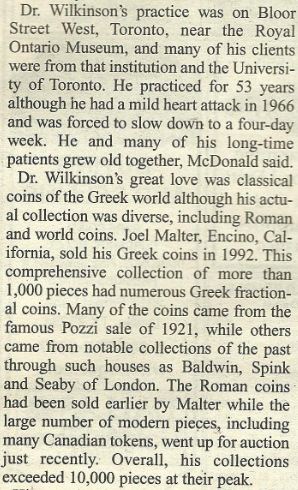
To read the earlier E-Sylum article, see: QUERY: INFORMATION ON DR. JOHN E. WILKISON SOUGHT (www.coinbooks.org/esylum_v14n42a15.html)
SKEWING - A TECHNIQUE FOR SIGNATURE IDENTIFICATION
Recently Paul Horner submitted a question about a hard-to-read signature.

John MacVean identified it as "Eugene Newman M.D." I couldn't have guessed that one in a million years, but Paul agreed, and he'd already been puzzling over the signature for some time.
This week Bill Eckberg writes:
The signature certainly looks like "Eugene Newman, MD" to me. For readers who may still be skeptical, I just copied the signature in Photoshop and used the "Skew" command to straighten the writing enough so it was legible. Et voila!

Wow! Neat idea. This does help make the signature more legible. Thanks! This technique could prove very useful for deciphering banknote, check and stock certificate signatures.
To read the earlier E-Sylum article, see: NORTH CAROLINA STATE TREASURY NOTE SIGNATURE IDENTIFIED (www.coinbooks.org/esylum_v14n42a07.html)
MEASURING IRREGULARLY SHAPED NUMISMATIC ITEMS
Last week Leon Saryan wrote:
Here's a question for the experts: Is there an accepted way to measure and report the diameter of an irregular (i.e. not exactly circular ancient or medieval era) coin?
If you have a problem measuring odd shaped coins, imagine the problem measuring medals and medallic items. Medals can appear in far more odd shapes and often have several parts attached to each other, as badges, decorations and such.. Thus, medal catalogers have come up with some rules to make the task easier. If you wish to adapt these for coins, be my guest.
1. Stretch out the item if it has chains or a ribbon to its greatest length.
2) Measure this length in metric -- millimeters or centimeters.
3) Measure the width at its widest point wherever that may be.
In other words, imagine the item in the tightest box in which it would fit -- measure the inside of that box -- height by width.
For a freeform medal determine its precise horizontal and vertical orientation. Again, measure the inside of a box in which it would fit, still maintaining that horizontal-vertical orientation.
If the item has a loop, disregard this in any measurement.
For medals list height first using metric then its width using "mm" or "cm," separated by a lower case "x" -- then translate Metric into Aliquot and add a single "-inch." In America we think in inches, but prefer Metric for its scientific accuracy. You can list inches first if you wish, I do (and add Metric in parenthesis).
Height is always listed first in numismatic cataloging. This is opposite to philately which always gives width first.
Circular coins and medals obviously need only one measurement -- its diameter anywhere.
Use a caliper to measure any numismatic item, never a ruler (for greater accuracy -- even to one-tenth of a millimeter). But metal calipers are not recommended -- they can scratch a surface. Instead use a plastic caliper. They are cheaper and just as satisfactory as metal calipers.
There is another term of measurement -- longest dimension -- but you don't have to worry about that since it is only used in diemaking. A blank diestock must be chosen for a rectangular medallic item to accommodate it longest dimension, diagonally from one corner across to its farthest corner.
To read the earlier E-Sylum article, see: QUERY: HOW TO MEASURE AN IRREGULARLY SHAPED COIN (www.coinbooks.org/esylum_v14n42a09.html)
ASSISTANCE WITH PERIODICALS SOUGHT FOR THE NBS ONLINE BIBLIOGRAPHY
Tom Wetter writes:
To visit the 100 Greatest section of the NBS site, see:
The One Hundred Greatest Items Of United States Numismatic Literature
(wiki.coinbooks.org/index.php/The_One_Hundred_Greatest
_Items_Of_United_States_Numismatic_Literature)
MORE ON THE SHIP OF THE LINE VIRGINIA
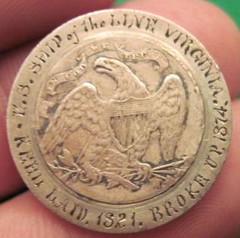 Last week Alan V. Weinberg shared images of a nautical love token for the "Virginia" on a host 1874 quarter dollar. This "Ship of the Line Virginia" was the third U.S. ship to bear the name "Virginia," being a 74-gun, North Carolina Class, "Ship of the Line" intended for 820 officers and enlisted men.
Last week Alan V. Weinberg shared images of a nautical love token for the "Virginia" on a host 1874 quarter dollar. This "Ship of the Line Virginia" was the third U.S. ship to bear the name "Virginia," being a 74-gun, North Carolina Class, "Ship of the Line" intended for 820 officers and enlisted men.
Ships of the Line were multiple deck, wooden sailing vessels designed for Napoleonic naval tactics such as sailing in a line to exchange broadsides with enemy lines of sail. This Virginia was authorized by Congress in 1816, laid down at the Boston Navy Yard starting in 1821 and was ready by 1825, a time when no U.S. naval battles were on the horizon.
She was kept in stocks, never launched, commissioned, or mothballed. At 197 feet long by 53 feet in beam and 22 feet depth of hold, she was held in reserve for decades and later served as a store ship, like a warehouse in port as the age of wind and wooden ships evaporated, in favor of screw-driven steam ships sheathed in iron cladding. Subsequent ships named "Virginia, " were more famous cousins.
This Boston love token documents the final "breaking" in 1874. Further research into the history of the Boston Navy Yard may reveal more stories about machinists that might feel the need to commemorate breaking a warship that never swam. Could this be a precursor to the "DaDa" movement, to honor warships with nonviolent and peaceful records, or did some salvage yard operator, sawing fifty year old oak beams back into lumber planks have special reason to note the provenance of this load of nautical scrap?
To read the earlier E-Sylum article, see: ON GERMAN ANHäNGER OR "GOOD FOR" MEDALS (www.coinbooks.org/esylum_v14n42a14.html)
WAYNE'S NUMISMATIC DIARY: OCTOBER 16, 2011
Tuesday evening was the October meeting of Nummis Nova, my Northern Virginia numismatic social group. This time we met at The Max Fox, a brew pub in Falls Church. Present were Tom Kays, Mike Packard, Ron Abler, Gene Brandenburg, Joe Levine, Jon Radel, Eric Schena, Dave Schenkman, Bill Eckberg, Chris Neuzil and S. Stewart.
Related to our earlier discussion of the origin of the U.S. dollar sign, Dave Schenkman asked the question, which was he first coin to bear the word "Dollar"? America's first dollar coin was minted in 1794. Dave proposed as the earliest a coin he'd brought to the meeting: a 1791 dollar of Sierra Leone. What do readers think? Is there an earlier coin with the word "dollar"?
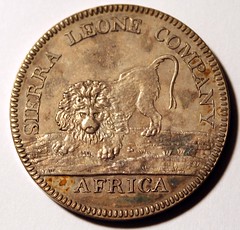

Among the points of discussion at my end of the table was a recent National Public radio story about moon rocks distributed to states and congressional districts in the 1970s. Many are now missing, having been lost or stolen over the years. To ease the problem of identification I suggested that the rocks should have been originally encased in something like a Lucite block with identification information and a serial number. Apparently that wasn't done and now we have a bunch of loose rocks that few understand the significance of. Someday someone will write a science fiction story where these missing rocks turn out to store a secret to save the Universe. Your ex-senator may be using one for a paperweight. Or his kid painted it like a ladybug for a gradeschool project.
Anyway, the topic of unearthly rocks led to another numismatic question for E-Sylum readers - has there ever been a coin, token or medal made from ore from a meteorite? None of us had an answer, but if anyone can help, it's probably one of our readers.
Wednesday evening I noticed an ad in the Tuesday Washington Post for a product of GovMint.com (see - I'm always behind the times in my reading). It was a replica of the Lovett "Confederate Cent". It got my attention since I never would have expected to see an image of this obscure item in a newspaper (obscure for the public anyway, not E-Sylum readers). It turns out this is another in the series of replicas authorized by the Smithsonian Institution - a portion of the proceeds supports the National Numismatic Collection.
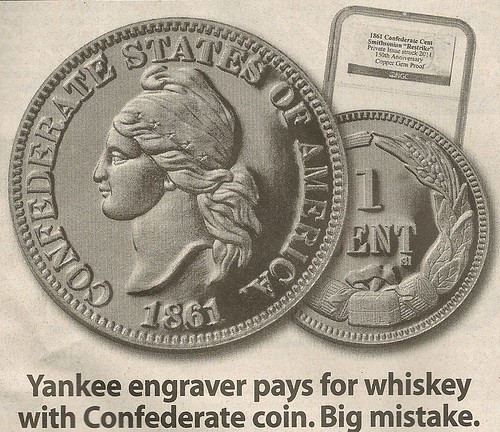
Later in the week I noticed Scott Barman's Coin Collectors Blog article about numismatic items featured on recent television shows. I don't see much TV, but I probably would have enjoyed these. Did anyone see them?
Those watching television in the evening had the opportunity to watch two shows were numismatics played a role in the story. On Monday night, CBS's Hawaii Five-0 had a story that included Spanish gold escudos and the Hawaii over-print dollars.... The note was used to help identify the body and the gold escudos were used to trace who was responsible for the murder. To see the full episode of "Mea Makamae," you can watch it on CBS's website...
One of my favorite shows is History Detectives on PBS. For those who have not seen the show, History Detectives explores the history behind artifacts that people find or are handed down by family members to discover its history and the history behind the objects. Anyone who loves history may want to add History Detectives to your must see list.
This past week, Gwen Wright, who is also a professor of architecture at Columbia University, investigate a stock certificate issued by the Harlem Associated Heirs Title Company.
The person who initiated the investigation was a collector of stock and bond certificates, a part of numismatics called scripophily. Those who collect these certificates have interests in financial history, the signatures, or artwork on the certificates.
To read the complete blog post, see: Numismatics On Television (coinsblog.blogspot.com/2011/10/numismatics-on-television.html)
On a related note, David Ganz sent a link to this History Channel episode which ran on October 5th. It also discusses Ft. Knox. From the web site:
Brad Meltzer's Decoded: Declaration of Independence (45:00)
Does the Declaration of Independence contain secret messages from the founders of the United States?
To view the complete show, see: Brad Meltzer's Decoded: Season 2 Full Episodes ()
QUERY: WHAT IS A SAMMY MARKS PENNY?
Dick Johnson forwarded the following item asking,
What is a Sammy Marks Penny?
With over 15 year's industry experience, South Cape Coins have long been considered one of South Africa's premier rare coin dealers. So when they launched their first rare coin competition in July earlier this year, there was immediate interest from local and international numismatic communities as well as South Cape Coin's existing customers and Facebook followers.
The competition prize was an incredibly rare 1898 Sammy Marks Penny, graded MS64 RB by independent coin grading company PCGS and valued at an astounding R45 000.
To read the complete article, see:
R 45,000 Rare Coin Competition Giveaway
(pressportal.co.za/business-and-economy/item
/5780-45000-rare-coin-competition-giveaway.html)
And here's a photo of the 1898 Sammy Marks Penny that could be yours!
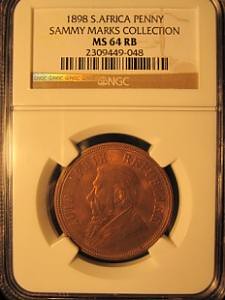
To read the complete article, see: WIN! 1898 Sammy Marks Penny MS64 RB (www.cointalk.com/t181471/)
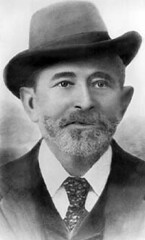 Samuel Marks, better known as Sammy Marks (1843 - 18 February 1920), was a South African industrialist and financier.
Samuel Marks, better known as Sammy Marks (1843 - 18 February 1920), was a South African industrialist and financier.
Marks contributed generously to Jewish communities all over South Africa. The Pretoria synagogue was built in 1898, for which he donated all the bricks and paid for the electric light installation and chandeliers. At the end of the Anglo-Boer War, he presented a cast-iron fountain to the city of Pretoria, shipped from Glasgow and very Edwardian in design, it stands at the Zoological Gardens. Marks commissioned the statue of Kruger on Church Square in Pretoria - sculpted by Anton van Wouw and cast in bronze in Europe, it carried a price tag of ₤10 000.
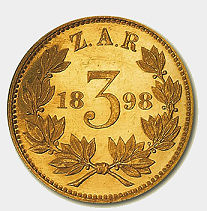 In 1898 Marks was allowed the extraordinary privilege of using the state mint for a day. He was awarded the Jewish Cross for his services to his race. Marks used the opportunity to strike 215 gold tickeys – three-penny pieces that were normally silver – as mementos for his relatives and friends, including President Kruger and members of the Volksraad. The gold would certainly have come from the Sheba mine near Barberton, the only gold mine in which Marks had a substantial stake.
In 1898 Marks was allowed the extraordinary privilege of using the state mint for a day. He was awarded the Jewish Cross for his services to his race. Marks used the opportunity to strike 215 gold tickeys – three-penny pieces that were normally silver – as mementos for his relatives and friends, including President Kruger and members of the Volksraad. The gold would certainly have come from the Sheba mine near Barberton, the only gold mine in which Marks had a substantial stake.
... in gratitude of his support of the Government and strong friendship with President Kruger, he was granted the opportunity of free use of the mint for a day, where he struck 215 gold Tickey's as mementos for his family, relatives and close friends.
The 1898 Sammy Marks Penny, however, was not struck by Marks himself but rather ordered for his own private collection. In total 240 of these bronze pennies were minted. What makes these coins exceptionally remarkable is that the majority have remained preserved and untouched in their original packaging.
In fact, Sammy Marks stated in his will of 1908 that the coins were not to be sold for 100 years, and so, in 2008 they were removed from the safe in their original mint bag. Only 210 of these coins have been graded with the Sammy Marks Pedigree on the capsule.
To read the complete article, see:
(www.southcapecoins.co.za/index.php/news
/the-story-behind-the-1898-sammy-marks-penny-that-you-can-win)
THE BOOK BAZARRE
THE CELTIC COIN INDEX
 How and why was the Celtic Coin Index founded? And what is there to celebrate? Setting up an index of Celtic coins found in Britain was first thought of in 1959 by the archaeologist Professor Sheppard Frere, excavator of Verulamium and author of Britannia (1967), and the numismatist Derek Allen (1910-75), who authored five books on Celtic coins (four of them for the British Museum) and who was the undisputed ‘king of Celtic coins' for thirty years.
How and why was the Celtic Coin Index founded? And what is there to celebrate? Setting up an index of Celtic coins found in Britain was first thought of in 1959 by the archaeologist Professor Sheppard Frere, excavator of Verulamium and author of Britannia (1967), and the numismatist Derek Allen (1910-75), who authored five books on Celtic coins (four of them for the British Museum) and who was the undisputed ‘king of Celtic coins' for thirty years.
Frere and Allen had previously collaborated on a coin gazetteer for Problems of the Iron Age in Southern Britain (1960) a collection of lectures given at a CBA conference held at the Institute of Archaeology, London, in 1958, which was edited by Frere and which contained Allen's pivotal paper ‘The origins of coinage in Britain: a reappraisal.'
Philip de Jersey writes: "As a result of his collaboration with Allen on this gazetteer and the discovery that many coins had become separated from their findspots, Frere realised that unlike mass-produced modern coinage, Celtic coins each possessed a unique identity, having been individually struck and with small differences resulting from the position of the dies. It followed that a photographic record would tie each coin to its context – even if its provenance was forgotten in the future – and would also facilitate the detailed study of die-chains. Early in 1959, Allen and Frere thus conceived the idea of the CCI: a record of every British Celtic coin, plus continental Celtic coins found on British soil.
Today the CCI comes under the protective wing of Chris Gosden, Professor of European Archaeology, University of Oxford, and co-editor of Communities and Connections: Essays in Honour of Barry Cunliffe (Oxford 2007) and Rethinking Celtic Art (Oxbow 2008). Moreover, the CCI now houses one of the world's finest libraries on Celtic numismatics, and at present the total number of CCI records exceeds 50,000 – an appropriate achievement for its 50th anniversary.
For fifty years the Celtic Coin Index at Oxford has quietly rendered a remarkable public service to British archaeology, British numismatics, British museums, British education, British scholarship and British metal detecting. It's worth noting here that over 80 per cent of the coins recorded by the CCI – that's four out of every five coins – have been found by metal detectorists since the 1970s. The growth of the CCI testifies to a commensurate increase in co-operation between professional archaeologists and amateur metal detectorists.
To read the complete article, see: 50 Years of Celtic Coin Index (www.coinsweekly.com/en/Article-of-the-week/5)

To access the Celtic Coin Index, see: www.finds.org.uk/CCI/
THE JOURNAL OF ANCIENT NUMISMATICS, VOLUME 4

Livia - The First Augusta of Rome
By: Marvin Tameanko
 When Augustus died in AD 14, he willed the title of ‘Augusta', the feminine form of Augustus, to his wife Livia Drusilla, his partner for 53 years. This is an excellent biography of Livia, the first Augusta of Rome.
When Augustus died in AD 14, he willed the title of ‘Augusta', the feminine form of Augustus, to his wife Livia Drusilla, his partner for 53 years. This is an excellent biography of Livia, the first Augusta of Rome.
Britain's First Coins
By: Chris Rudd
They are cheaper than Greek, rarer than Roman, more bizarre than Byzantine, sexier than Anglo-Saxon, more British than English hammered, and more fun than foreign banknotes. That's the magic of Celtic coins, the first coins made in Britain.
A fantastic introduction to British Celtic coins.
The World of Coin Forgery
By: Ilya Prokopov
A small group of enthusiasts from different countries are trying to draw the attention of the ministries of culture, the national and international institutions of justice, and police groups to the painful subject of the production and sale of ancient coin fakes. This problem stays in the shadows and there is no trend towards enlightenment. The real reasons for this secrecy are known to few. Although public, the secrecy itself remains a secret.
A Strange Fantasy Caracalla Overstruck on Menander
By: David MacDonald
The inherent improbability of such an overstrike provokes immediate suspicion. Menander's drachms are the most common Indo-Greek silver coins and are known to have remained long in circulation, but it is unlikely a well-preserved example made its way to Rome after some three and half centuries and even less likely that such a coin would have been overstruck by the Roman mint.
Vilonius Strabo
By: Mark Passehl
There is a problem with the abbreviated clan name, and therefore basic identity, of the Roman mint magistrate responsible for Crawford's type 377: a small issue of denarii serrati, struck around 80 B.C. with an unusually spectacular reverse design of Zeus' taurus conveying Europa from Tyre to Crete. Crawford presents the legend as L. VOL L.F STRAB (RRC, 391), apparently following a scholarly consensus.
Black Sea Hoard Controversy Dies with a Whimper
By: Wayne G. Sayles
It is only fitting that an issue that has a strong emphasis on forgeries of ancient coins should include an article which discusses the conclusion to one of the most controversial events concerning forgeries.
The Birth of Islamic Coinage - The Orthodox and Umayyad Caliphate
By: Sameer Kazmi
An excellent introduction to Islamic Coinage. At the advent of Islam, Arabia for the most part had a very limited numismatic history of its own. The past local coinage seems to be limited to that of the Sabaeans, the Himyarites, the Nabataens, and Rome's Provencia Arabia. However, by Muhammad's birth, these were already centuries old.
Images of Africa on Roman Imperatorial Coinage as Propaganda at the End of the Republic
By: Gabriella Vlahovici Jones
In the second century A.D., Appian of Alexandria embarks on the monumental undertaking of writing a Roman History. Only the Civil Wars survive today – a testimony to the Greek intellectual's attempt at unraveling the series of events that brought about the fall of the Republic.
To read the complete issue, see: Journal of Ancient Numismatics, Volume 4 (imperialcoins.com/newsletters/volume4/index.html)
MORE ON ENGRAVER PHILIP RANDALL
Regarding the 1872 Boston International Peace Jubilee Medal, Kay Olson Freeman writes:
The medal's maker is Philip Green Randall who is not a "Jno" or "Junior". His father's name was Charles Randall.
There is no one in his ancestry with his name and, if there was, Randall would be styled "II"; not "Jr".
The medal is marked "P.G. Randall & Co" which was used in Boston City Business Directories listing of die sinkers and letter cutters, 82 Sudbury St. - a later address than 41 Arch St.
Philip G. Randall was born March 16, 1851, Mattapoisett, MA and died Dec. 28, 1925, Malden, MA, He is always listed as an engraver or die sinker in census. His father, Charles Randall (1822-1893) was a caulker in ship building.
[There is another Philip Green Randall (1876-1902) in Massachusetts who is not related, never worked, and spent much of his short life in California and Arizona due to ill health]
The Randall marked International Peace Jubilee medal clearly says at bottom "Pat. June 18, 1868." I did not find a patent for it. There is a Design patent #5937, June 18, 1872, for a Peace Jubilee Medal in shape of Maltese Cross granted to George Frederick Crook of Cambridge, MA. This design is totally different than Randall's. Crook did not make medals; he was a printer/publisher.
Philip G. Randall's advertisement says he is successor to William N. Weeden (born 1841, New Bedford, MA - died 1891, New Bedford, MA). Weeden left his letter cutting business in Boston in 1870's to live in Waterbury, CT and work for Benedict & Burnham Manufacturing Co. Weeden was foreman/supt. of very important factory which involved brass and watch and clock making.
Weeden has @ 24 patents for a variety of uses. When Weeden was in Boston, July 10, 1866, a seal or embossing press was patented by him and John Merriam, who was a die sinker. Weeden returned from Waterbury to New Bedford in 1883.
Ron Abler writes:
The two medals that Dick Johnson cites as Holland 4 and 5 are Randall's Antiques and Horribles (A&H) medal and his Joseph Warren (JW) medal. I have attached images of both, including blow-ups of Randall's signature from each. I agree with Dick. In both cases, the Randall that did these two medals signed his name as RANDALL SC. In addition, both of these Centennial medals are more amateurishly executed than the International Peace Jubilee shell.
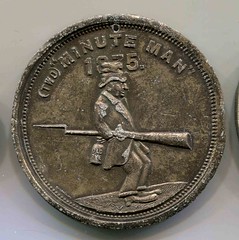
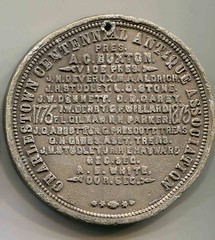
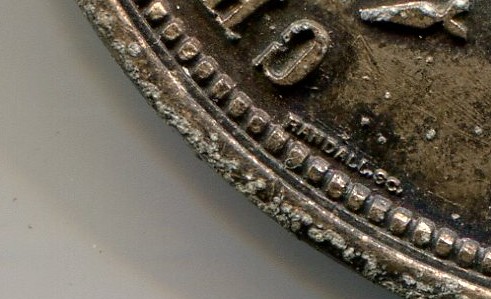
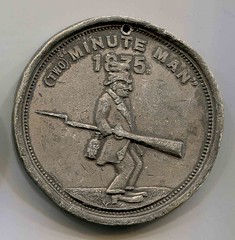

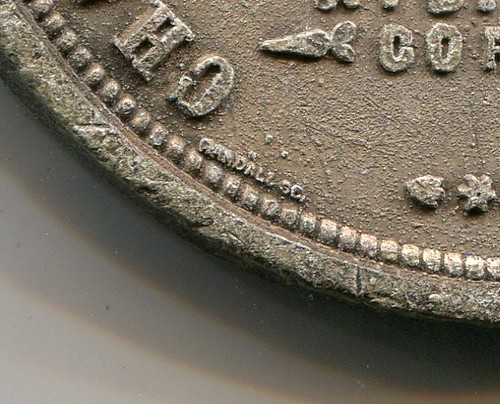
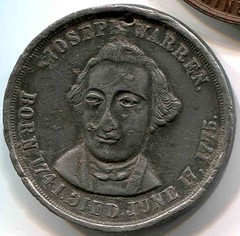
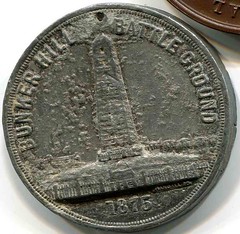

To read the earlier E-Sylum article, see: 1872 INTERNATIONAL PEACE JUBILEE MEDAL ENGRAVER: PHILIP RANDALL (www.coinbooks.org/esylum_v14n42a06.html)
STAMPS ON PAPER MONEY
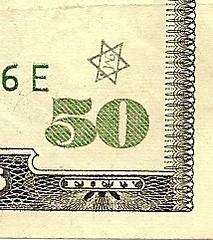 Web site visitor Adamandia Kapsalis writes:
Web site visitor Adamandia Kapsalis writes:
I saw your article, STAR STAMPS ON PAPER MONEY: MODERN CHOP MARKS. I have been collecting photos of a variety of stamp marks on the money I deposit for the place I work at. Do you know of any book listing the sources of these stamps?
I replied:
No, I'm not aware of any book or web site with information on the sources of these. Many will never be known, although I'm sure there are a number that could be traced. If you have a lot of photos, they would be a great start for a web site. Maybe people who have information will find your site and contact you.
As it turns out, Adamandia has an album of her photos on Facebook. Here are a few.
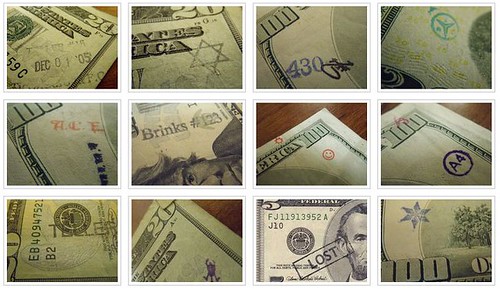
Adamandia adds:
I found one with Hello Kitty as the image. Seems odd for a government or a bank to use that for their authentication mark.
"Chopmarks" like these are made by private merchants and individuals, so I guess Hello Kitty is as likely as any other stamp. But not all stamps are chopmarks to indicate authenticity. Some stamps are just there for the fun of it.
To view the complete set of images, see:
Found Stamp Marks on US Currency
By Adamandia Kapsalis
To read the earlier E-Sylum article, see: STAR STAMPS ON PAPER MONEY: MODERN CHOP MARKS (www.coinbooks.org/esylum_v11n36a10.html)
KOLBE & FANNING NUMISMATIC BOOKSELLERS WEBSITE
NOTES FROM E-SYLUM READERS: OCTOBER 16, 2011
BROWSER'S DELIGHT
From Europe Dave Hirt writes:
I brought some newspapers with me, and did not get around to reading them for some time. I found an article in the weekend edition of the August 13-14 Wall Street Journal that I REALLY enjoyed reading it, thinking "This is me"!
It was titled BROWSER'S DELIGHT, by Henrick Bering, and was about the joy of reading through auction catalogs. He said that as a boy their house was filled with auction catalogs, and he became interested in them. Of how he took them with him on trips to read when things are dull.
I remember Armand Champa telling me that he also did that. Of how everything else stops when an auction catalog arrives. "That's me"!
The catalogs discussed are mostly art and antiques, but book catalogs are mentioned. It was such a surprise to find this great article, and for sure I will save it.
George W. Rode, ANA Pioneer
Pete Smith writes:
E-Sylum readers should note an article by our own Wayne Homren in the October 2011 issue of The Numismatist. Under the title of "Anonymous Pioneer," Homren tells the story of George W. Rode who was a founding member of the Western Pennsylvania Numismatic Society and Charter Member 12 of the ANA.
The sub-heading of the article makes this remarkable claim, "In the late 1850's, George W. Rode embraced and nurtured the blossoming public interest in the hobby." Later in the article it mentions that Rode was born in 1858 or 1859. Thus the young Rode was already nurturing the hobby by the age of one. This must be a record for the accomplishments of a young numismatist.
Many thanks to The Numismatist editor Barbara Gregory and her staff for publishing the article this month, coinciding with the ANA show which took place in Pittsburgh this week. Rode was a real pioneer of the numismatic hobby in the U.S., and played a key role in holding the ANA's first true convention in Pittsburgh in 1892. -Editor
Dan Tague's Money Art
Dick Johnson commented (in terms not entirely suitable for family consumption) about Dan Tague's Money Art. He writes (in part):
His folded currency is not art. It's dollar bills he has played with. Tsch!
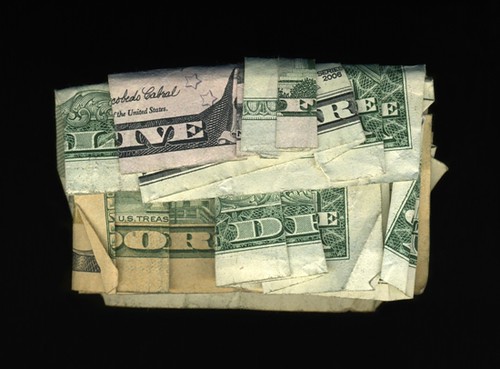 "Live Free or Die"
"Live Free or Die"
To read the earlier E-Sylum article, see: THE ORIGAMI-STYLE MONEY SCULPTURES OF ARTIST DAN TAGUE (www.coinbooks.org/esylum_v14n42a21.html)
Joe Boling writes:
Apropos of our earlier exchanges about newspaper websites not saying where they are, The News Tribune that reported the Lakewood challenge coins is a Tacoma newspaper. Lakewood is between Tacoma and Ft Lewis (now known by the incredibly ugly name "Joint Base Lewis-McChord").
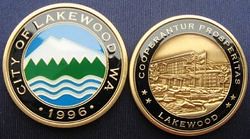
To read the earlier E-Sylum article, see: CITY OF LAKEWOOD CHALLENGE COIN (www.coinbooks.org/esylum_v14n42a17.html)
Buy Paul Bosco's Inventory For One Low Price
Alan V. Weinberg pointed out this amusing eBay lot posted by dealer Paul Bosco:
1400s-2000s, About 50,000 pcs, all kinds, many gold.
US/World. BOSCO INVENTORY
Current price: $7,687,503.00
End time: Oct-18-11 20:35:02 PDT
NOTHING HELD BACK!! The complete Paul Bosco inventory, probably now well over 50,000 pieces, since I just bought 600 more, including a full Society of Medalists set and the official 1925 Paris Art-Deco Expo by Pierre Turin (bronze & silver pair). Many were acquired in the early 1990s. There are 300+ different medical and music medals. It includes the THOUSANDS of medals put aside for my future auctions , in these specialties:
- Printing/Franklin
- Military
- Numismatic (see WEBSITE for listing)
- Judaica (see WEBSITE for listing)
- Simon Bolivar (see WEBSITE for listing)
- Golf
- Aviation (the Otto Kallir Collection, plus additions)
- Renaissance (including the Max Falk Collection)
- Turkish Wars
- US Art Medals
- World Art Medals
- Unlisted V.D. Brenner & Karl Goetz medals
Something like 4,000 medals are listed on my website. ONE PRICE GETS THEM ALL!!!
If you are concerned about whether or not PayPal can process a $6,000,000 transfer, well.........We'll cross that bridge when we come to it.
If you would like to come to my store to examine the material, I may need a letter from your banker. DEFINITELY from your psychiatrist.
You will probably never BE Paul Bosco. In practical terms, BUYING Paul Bosco is the closest you can get. Do not let this unique opportunity slip thru your fingers.
For more information about me, see my About Me page or Google me to find my website.
This listing cost me one cent.
To read the complete auction description, see: 1400s-2000s, About 50,000 pcs, all kinds, many gold. US/World. BOSCO INVENTORY (www.ebay.com/itm/300609501784#ht_861wt_1139)
ROYAL MINT ISSUES DIAMOND JUBILEE FIVE POUND COMMEMORATIVE
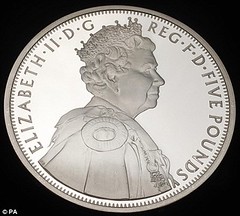
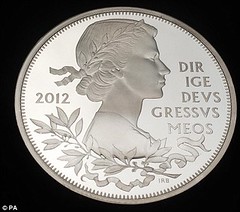
A commemorative £5 coin with two heads celebrating the Queen's Diamond Jubilee has been launched by the Royal Mint.
The collectors' piece features two new portraits of the Queen by celebrated sculptor Ian Rank-Broadley.
The first of the images shows the Royal as she appears today, dressed in formal Garter robes.
On the reverse the artwork is inspired by the first portrait of the Queen to appear on coins from 1953, and features a youthful Elizabeth classically depicted wearing a laurel crown.
Kevin Clancy, director of the Royal Mint museum, said: "Working with some of the finest artists in Britain, the Royal Mint has captured the Queen's likeness on the coinage for almost 60 years and in her Diamond Jubilee year we wanted to honour her remarkable achievements with a remarkable coin. 'Ian's new portraits tell the story of the Queen's long reign with beauty and elegance, dignity and character, evoking the spirit of the Queen as only a truly gifted artist can."
Following normal practice, the design for the coin was approved by Buckingham Palace.
The first circulating coin featuring the Queen's portrait was designed in 1953 by Mary Gillick when the monarch was 27.
The image appeared on pre-decimalisation coins including the farthing, shilling and florin.
A second portrait appeared in 1968 designed by Arnold Machin, Raphael Maklouf designed the third portrait in 1985, depicting the Queen in her late fifties, and Mr Rank-Broadley created the fourth in 1998.
The Queen celebrates her Diamond Jubilee next year when the focus of the celebrations will be an extended four-day bank holiday weekend in June.
To read the complete article, see:
I'll call heads: Royal mint's £5 jubilee coin features portrait of the Queen on both sides
(www.dailymail.co.uk/news/article-2048129/Queen-Elizabeth
-Diamond-Jubilee-Royal-mints-5-commemorative-coin.html)
DAILY MAIL ARTICLE ON ELIMINATING THE U.S. DOLLAR BILL
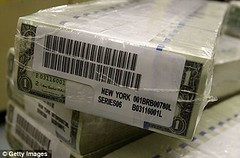 Many aspects of the debates that Washington politicians grumble over have little immediate effect on people's day to day lives.
Many aspects of the debates that Washington politicians grumble over have little immediate effect on people's day to day lives.
The newest issue will be felt in the wallets of every resident. Literally.
A number of congressmen are hoping to replace the dollar bill with a dollar coin, suggesting that the move would help bring down the national deficit and increase the efficiency of U.S. currency.
Republican Representative David Schweikert from Arizona introduced legislation that he says will transition the standard U.S. dollar out of circulation in the next four years.
The motivations behind the bill are economic, he said.
'At a time when we are staring down a record-breaking $1.3trillion deficit, any common-sense measure that cuts billions needs to be given serious consideration,' Mr Schweikert said.
The bill that was introduced to the House of Representatives is named the Currency Optimization, Innovation and National Savings Act, which comes out with the handy acronym COINS.
'That is exactly what the COINS Act will do and why I am introducing it,' Mr Schweikert said.
There is currently a dollar coin in circulation that people can use, but it has not caught on in any significant way because dollar bills are still more widely used. If the new legislation is adopted, dollar bills will be entirely eliminated, making the dollar coin the only option.
To read the complete article, see:
Will $1 bill be ditched? Congressmen plan to replace them forever with a coin
(www.dailymail.co.uk/news/article-2048555/Will-1-
ditched-Congressmen-plan-replace-forever-coin.html)
HOW NOT TO STORE A COIN COLLECTION
Bob Merchant writes:
Here is an interesting lot on eBay. This coin collection is almost a collectible itself.
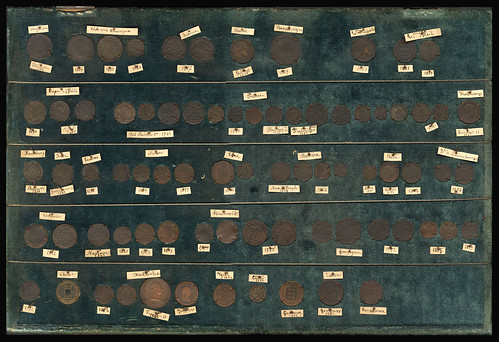

To view the complete eBay lot description, see: Collection de 78 Monnaies XIXe Europe Haiti Caraibes Ameriques Coll Hubert Comte (www.ebay.com/itm/330624939652#ht_7351wt_1037)
FEATURED WEB PAGE: ATTINELLI'S NUMISGRAPHICS
This week's Featured Web Page is from The One Hundred Greatest Items Of United States Numismatic Literature section of the Numismatic Bibliomania Society web site.
ATTINELLI, Emmanuel J. NUMISGRAPHICS, OR A LIST OF CATALOGUES IN WHICH OCCUR COINS OR MEDALS WHICH HAVE BEEN SOLD BY AUCTION IN THE UNITED STATES. ALSO A LIST OF CATALOGUES OR PRICE LIST OF COINS ISSUED BY DEALERS. ALSO A LIST OF VARIOUS PUBLICATIONS OF MORE OR LESS INTEREST TO NUMISMATOLOGISTS WHICH HAVE PUBLISHED IN THE UNITED STATES, COMPILED BE E. J. ATTINELLI. PRICE, TWO DOLLARS.
New York: 1876
123pp
Quarto: 27.5 x 18 cm
Softbound: Gray printed wrappers

wiki.coinbooks.org/index.php/NUMISGRAPHICS
